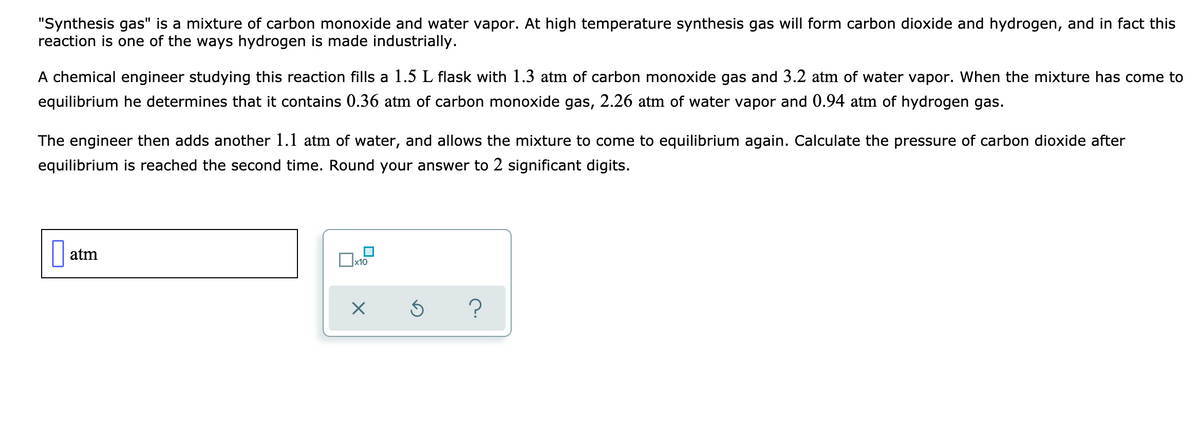"Synthesis gas" is a mixture of carbon monoxide and water vapor. At high temperature synthesis gas will form carbon dioxide and hydrogen, and in fact this reaction is one of the ways hydrogen is made industrially. A chemical engineer studying this reaction fills a 1.5 L flask with 1.3 atm of carbon monoxide gas and 3.2 atm of water vapor. When the mixture has come to equilibrium he determines that it contains 0.36 atm of carbon monoxide gas, 2.26 atm of water vapor and 0.94 atm of hydrogen gas. The engineer then adds another 1.1 atm of water, and allows the mixture to come to equilibrium again. Calculate the pressure of carbon dioxide after equilibrium is reached the second time. Round your answer to 2 significant digits. atm
"Synthesis gas" is a mixture of carbon monoxide and water vapor. At high temperature synthesis gas will form carbon dioxide and hydrogen, and in fact this reaction is one of the ways hydrogen is made industrially. A chemical engineer studying this reaction fills a 1.5 L flask with 1.3 atm of carbon monoxide gas and 3.2 atm of water vapor. When the mixture has come to equilibrium he determines that it contains 0.36 atm of carbon monoxide gas, 2.26 atm of water vapor and 0.94 atm of hydrogen gas. The engineer then adds another 1.1 atm of water, and allows the mixture to come to equilibrium again. Calculate the pressure of carbon dioxide after equilibrium is reached the second time. Round your answer to 2 significant digits. atm
Chemistry for Engineering Students
4th Edition
ISBN:9781337398909
Author:Lawrence S. Brown, Tom Holme
Publisher:Lawrence S. Brown, Tom Holme
Chapter12: Chemical Equilibrium
Section: Chapter Questions
Problem 12.116PAE
Related questions
Question

Transcribed Image Text:"Synthesis gas" is a mixture of carbon monoxide and water vapor. At high temperature synthesis gas will form carbon dioxide and hydrogen, and in fact this
reaction is one of the ways hydrogen is made industrially.
A chemical engineer studying this reaction fills a 1.5 L flask with 1.3 atm of carbon monoxide gas and 3.2 atm of water vapor. When the mixture has come to
equilibrium he determines that it contains 0.36 atm of carbon monoxide gas, 2.26 atm of water vapor and 0.94 atm of hydrogen gas.
The engineer then adds another 1.1 atm of water, and allows the mixture to come to equilibrium again. Calculate the pressure of carbon dioxide after
equilibrium is reached the second time. Round your answer to 2 significant digits.
|| atm
x10
Expert Solution
This question has been solved!
Explore an expertly crafted, step-by-step solution for a thorough understanding of key concepts.
This is a popular solution!
Trending now
This is a popular solution!
Step by step
Solved in 3 steps

Knowledge Booster
Learn more about
Need a deep-dive on the concept behind this application? Look no further. Learn more about this topic, chemistry and related others by exploring similar questions and additional content below.Recommended textbooks for you

Chemistry for Engineering Students
Chemistry
ISBN:
9781337398909
Author:
Lawrence S. Brown, Tom Holme
Publisher:
Cengage Learning

Chemistry: Principles and Reactions
Chemistry
ISBN:
9781305079373
Author:
William L. Masterton, Cecile N. Hurley
Publisher:
Cengage Learning

General Chemistry - Standalone book (MindTap Cour…
Chemistry
ISBN:
9781305580343
Author:
Steven D. Gammon, Ebbing, Darrell Ebbing, Steven D., Darrell; Gammon, Darrell Ebbing; Steven D. Gammon, Darrell D.; Gammon, Ebbing; Steven D. Gammon; Darrell
Publisher:
Cengage Learning

Chemistry for Engineering Students
Chemistry
ISBN:
9781337398909
Author:
Lawrence S. Brown, Tom Holme
Publisher:
Cengage Learning

Chemistry: Principles and Reactions
Chemistry
ISBN:
9781305079373
Author:
William L. Masterton, Cecile N. Hurley
Publisher:
Cengage Learning

General Chemistry - Standalone book (MindTap Cour…
Chemistry
ISBN:
9781305580343
Author:
Steven D. Gammon, Ebbing, Darrell Ebbing, Steven D., Darrell; Gammon, Darrell Ebbing; Steven D. Gammon, Darrell D.; Gammon, Ebbing; Steven D. Gammon; Darrell
Publisher:
Cengage Learning

Introduction to General, Organic and Biochemistry
Chemistry
ISBN:
9781285869759
Author:
Frederick A. Bettelheim, William H. Brown, Mary K. Campbell, Shawn O. Farrell, Omar Torres
Publisher:
Cengage Learning

Principles of Modern Chemistry
Chemistry
ISBN:
9781305079113
Author:
David W. Oxtoby, H. Pat Gillis, Laurie J. Butler
Publisher:
Cengage Learning

Chemistry: An Atoms First Approach
Chemistry
ISBN:
9781305079243
Author:
Steven S. Zumdahl, Susan A. Zumdahl
Publisher:
Cengage Learning